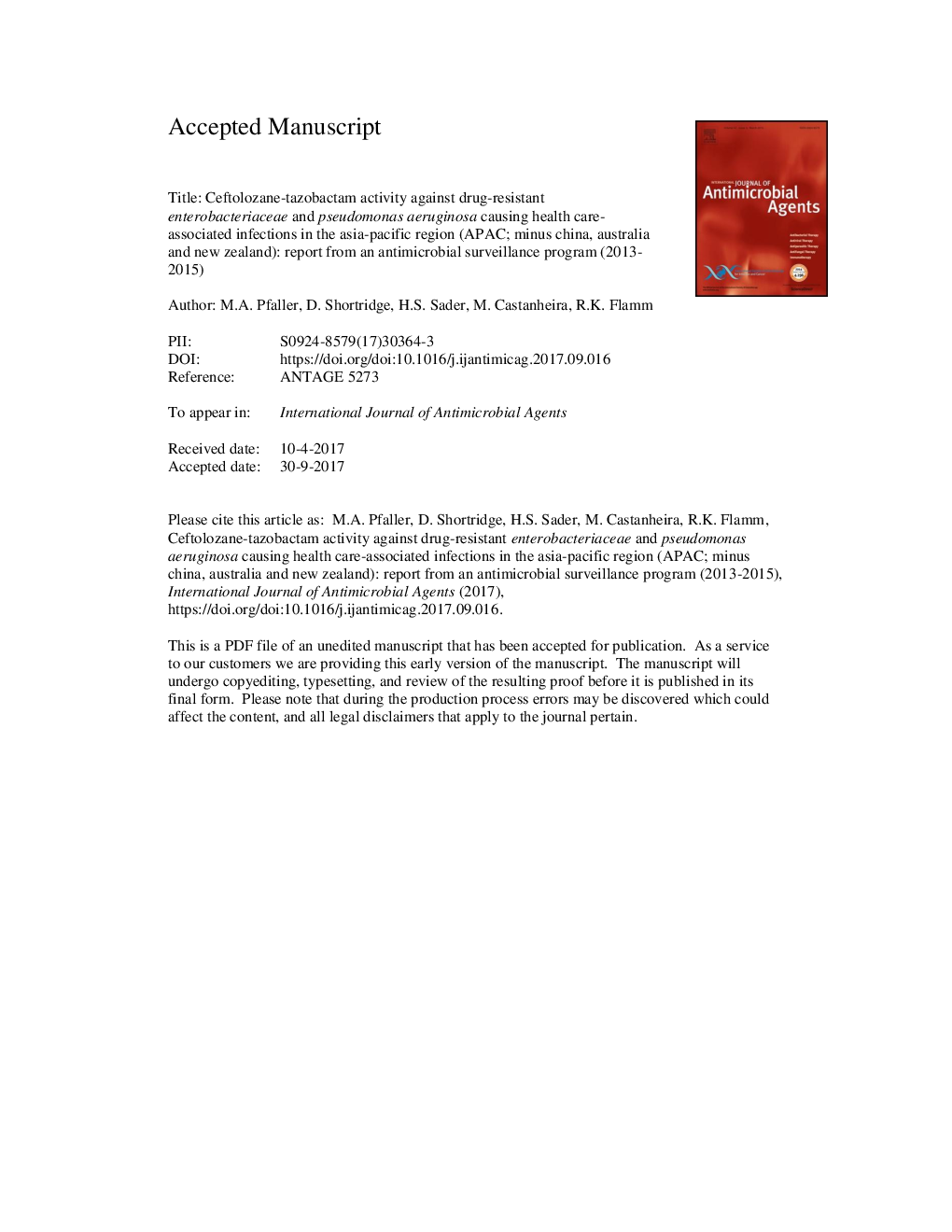| کد مقاله | کد نشریه | سال انتشار | مقاله انگلیسی | نسخه تمام متن |
|---|---|---|---|---|
| 8738659 | 1591732 | 2018 | 32 صفحه PDF | دانلود رایگان |
عنوان انگلیسی مقاله ISI
Ceftolozane/tazobactam activity against drug-resistant Enterobacteriaceae and Pseudomonas aeruginosa causing healthcare-associated infections in the Asia-Pacific region (minus China, Australia and New Zealand): report from an Antimicrobial Surveillance Pr
دانلود مقاله + سفارش ترجمه
دانلود مقاله ISI انگلیسی
رایگان برای ایرانیان
کلمات کلیدی
موضوعات مرتبط
علوم زیستی و بیوفناوری
ایمنی شناسی و میکروب شناسی
میکروبیولوژی و بیوتکنولوژی کاربردی
پیش نمایش صفحه اول مقاله

چکیده انگلیسی
The aim of this study was to evaluate the in vitro activity of ceftolozane/tazobactam and comparator agents tested against Enterobacteriaceae and Pseudomonas aeruginosa isolates from patients in the Asia-Pacific (APAC) region with healthcare-associated infections. Ceftolozane/tazobactam is an antipseudomonal cephalosporin combined with a well-established β-lactamase inhibitor. A total of 1963 Gram-negative organisms (489 P. aeruginosa and 1474 Enterobacteriaceae) were consecutively collected using a prevalence-based approach from 14 medical centres in the APAC region. Antimicrobial susceptibility testing was performed by broth microdilution method as described by the CLSI and the results were interpreted according to EUCAST and CLSI breakpoint criteria. Ceftolozane/tazobactam [MIC50/90, 0.25/4âµg/mL; 89.2/85.8% susceptible (CLSI/EUCAST)] and meropenem [MIC50/90, â¤0.06/â¤0.06âµg/mL; 96.3/96.5% susceptible (CLSI/EUCAST)] were the most active compounds tested against Enterobacteriaceae. Isolates displayed susceptibility rates to other β-lactam agents ranging from 85.8/81.0% for piperacillin/tazobactam to 74.4/72.7% for cefepime and 72.8/68.1% for ceftazidime using CLSI/EUCAST breakpoints. Among the Enterobacteriaceae isolates, 3.6% were carbapenem-resistant Enterobacteriaceae (CRE) and 25.6% exhibited an extended-spectrum β-lactamase (ESBL) non-CRE phenotype. Ceftolozane/tazobactam showed good activity against ESBL non-CRE phenotype strains of Enterobacteriaceae (MIC50/90, 0.5/16âµg/mL), but not against isolates with a CRE phenotype (MIC50/90, >32/>32âµg/mL). Ceftolozane/tazobactam was the most potent (MIC50/90, 0.5/4âµg/mL) β-lactam agent tested against P. aeruginosa isolates, inhibiting 90.8% at an MIC of â¤4âµg/mL. Pseudomonas aeruginosa exhibited high rates of susceptibility to amikacin [91.2/89.4% (CLSI/EUCAST)] and colistin [98.4/100.0% (CLSI/EUCAST)]. Ceftolozane/tazobactam was the most active β-lactam agent tested against P. aeruginosa and demonstrated higher in vitro activity than available cephalosporins when tested against Enterobacteriaceae.
ناشر
Database: Elsevier - ScienceDirect (ساینس دایرکت)
Journal: International Journal of Antimicrobial Agents - Volume 51, Issue 2, February 2018, Pages 181-189
Journal: International Journal of Antimicrobial Agents - Volume 51, Issue 2, February 2018, Pages 181-189
نویسندگان
M.A. Pfaller, D. Shortridge, H.S. Sader, M. Castanheira, R.K. Flamm,